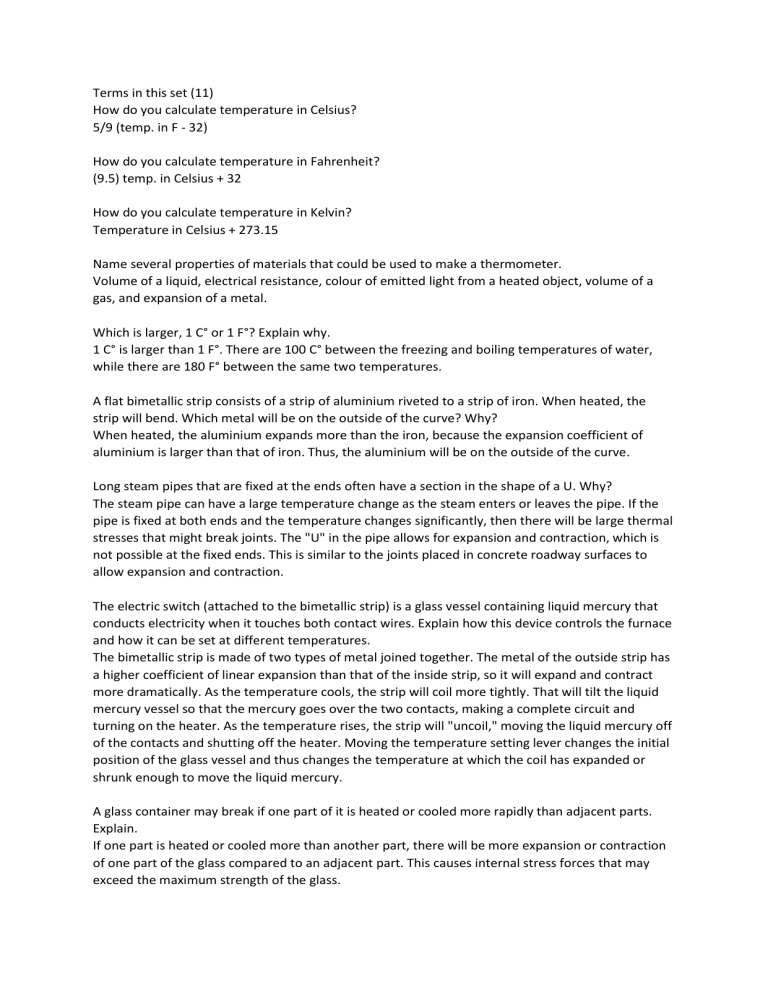
Terms in this set (11) How do you calculate temperature in Celsius? 5/9 (temp. in F - 32) How do you calculate temperature in Fahrenheit? (9.5) temp. in Celsius + 32 How do you calculate temperature in Kelvin? Temperature in Celsius + 273.15 Name several properties of materials that could be used to make a thermometer. Volume of a liquid, electrical resistance, colour of emitted light from a heated object, volume of a gas, and expansion of a metal. Which is larger, 1 C° or 1 F°? Explain why. 1 C° is larger than 1 F°. There are 100 C° between the freezing and boiling temperatures of water, while there are 180 F° between the same two temperatures. A flat bimetallic strip consists of a strip of aluminium riveted to a strip of iron. When heated, the strip will bend. Which metal will be on the outside of the curve? Why? When heated, the aluminium expands more than the iron, because the expansion coefficient of aluminium is larger than that of iron. Thus, the aluminium will be on the outside of the curve. Long steam pipes that are fixed at the ends often have a section in the shape of a U. Why? The steam pipe can have a large temperature change as the steam enters or leaves the pipe. If the pipe is fixed at both ends and the temperature changes significantly, then there will be large thermal stresses that might break joints. The "U" in the pipe allows for expansion and contraction, which is not possible at the fixed ends. This is similar to the joints placed in concrete roadway surfaces to allow expansion and contraction. The electric switch (attached to the bimetallic strip) is a glass vessel containing liquid mercury that conducts electricity when it touches both contact wires. Explain how this device controls the furnace and how it can be set at different temperatures. The bimetallic strip is made of two types of metal joined together. The metal of the outside strip has a higher coefficient of linear expansion than that of the inside strip, so it will expand and contract more dramatically. As the temperature cools, the strip will coil more tightly. That will tilt the liquid mercury vessel so that the mercury goes over the two contacts, making a complete circuit and turning on the heater. As the temperature rises, the strip will "uncoil," moving the liquid mercury off of the contacts and shutting off the heater. Moving the temperature setting lever changes the initial position of the glass vessel and thus changes the temperature at which the coil has expanded or shrunk enough to move the liquid mercury. A glass container may break if one part of it is heated or cooled more rapidly than adjacent parts. Explain. If one part is heated or cooled more than another part, there will be more expansion or contraction of one part of the glass compared to an adjacent part. This causes internal stress forces that may exceed the maximum strength of the glass. Will a clock using a pendulum supported on a long thin brass rod that is accurate at 20°C run fast or slow on a hot day (30°C)? Explain. On a hot day, the pendulum will be slightly longer than at 20°C, due to thermal expansion of the brass rod. Since the period of a pendulum is proportional to the square root of its length, the period will be slightly longer on the hot day, meaning that the pendulum takes more time for one oscillation. Thus, the clock will run slow. Freezing a can of soda will cause its bottom and top to bulge so badly the can will not stand up. What has happened? The soda is mostly water. As water cools below 4°C it expands. There is more expansion of the soda as it cools below 4°C and freezes than there is available room in the can (the can has actually shrunk a small amount, making the mismatch more pronounced), so the freezing soda pushes against the can surfaces hard enough to push them outward. Evidently the top and bottom of the can are the weakest parts.


